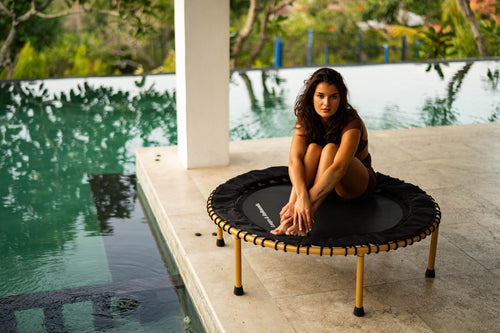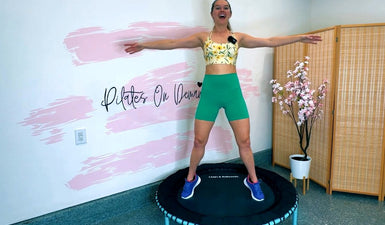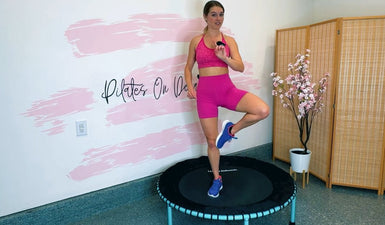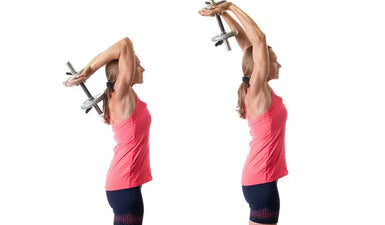Finding ways to help children with autism is something many parents think about. It's about making their days a little easier and more enjoyable. Lately, there's been a lot of talk about mini trampolines, or rebounding, and how it might be a surprisingly good fit. It's not just about jumping around; it seems to offer some real benefits for kids who need a bit of extra support. So, how rebounding can improve quality of life for children with autism? Let's take a look.
Key Takeaways
- Rebounding provides rhythmic, repetitive movement that can help children with autism focus better on tasks and calm their energy.
- Bouncing on a mini trampoline releases feel-good chemicals like endorphins and serotonin, which can lift a child's mood and reduce feelings of anxiety.
- The predictable motion of rebounding offers calming sensory input, helping children regulate their arousal levels and feel more in control.
- Even short sessions of rebounding can sharpen a child's concentration, improve their working memory, and build better body awareness.
- Mini trampolines are easy to store and use at home, making them a practical way for families to engage in active play together and reduce screen time.
Understanding the Need for Movement in Neurodivergent Children
Many neurodivergent children have a natural, strong need for movement. It's not just about burning off energy; it's a fundamental part of how they process the world, manage their feelings, and stay focused. For kids with autism or ADHD, this need for physical activity can be particularly pronounced. Finding ways to channel this energy constructively is key to helping them thrive.
The Rhythmic Nature of Rebounding for Focus
Think about it: when a child is constantly fidgeting or seeking out movement, they're often trying to get their brain to pay attention. Rhythmic, repetitive motions can be incredibly helpful here. It's like a gentle hum that helps their internal systems settle down and tune in. This kind of movement is predictable and steady, which can make it easier for them to concentrate on other things, like listening to instructions or completing a task. It's a way to get their body moving without it becoming a distraction.
Channelling Energy Through Static, Rhythmical Movement
This is where rebounding really shines. Unlike running around wildly, bouncing on a mini trampoline offers a contained, rhythmic form of movement. It allows children to expend physical energy in a way that's actually conducive to focus. It’s a way to satisfy that urge to move, but in a way that can paradoxically help them sit still and concentrate better afterward. It’s about finding that sweet spot where movement supports, rather than hinders, attention. This type of activity can be a game-changer for parents trying to help their kids engage with homework or other seated activities. You can find some great options for mini trampolines that are perfect for this.
Stimulating the Vestibular System for Cognitive Gains
Bouncing up and down on a rebounder does more than just feel good; it actively engages the vestibular system. This system, located in our inner ear, is responsible for balance, spatial awareness, and processing movement. When it's stimulated, it can have a positive ripple effect on cognitive functions. This includes things like:
- Improved concentration
- Better coordination
- Enhanced spatial reasoning
Essentially, giving the vestibular system a good workout through bouncing can help wire the brain for better learning and attention. It's a physical activity with surprising cognitive payoffs.
For many neurodivergent children, movement isn't a choice; it's a necessity for regulation and engagement. Rebounding offers a structured, enjoyable way to meet this need, leading to calmer minds and sharper focus.
Boosting Mood and Emotional Well-being Through Bouncing
It's pretty amazing how a simple mini trampoline can make such a difference in a child's mood. When kids bounce, their bodies naturally release endorphins, those feel-good chemicals that act like a little mood boost. Think of it as a natural pick-me-up. Plus, serotonin levels get a nice bump, which helps with feeling calm and balanced. For kids who might struggle with anxiety or just need a little help regulating their emotions, this can be a game-changer.
The Role of Endorphins and Serotonin in Mood Elevation
Exercise, and rebounding is definitely exercise, is well-known for its impact on brain chemistry. The rhythmic bouncing on a mini trampoline triggers the release of endorphins. These are natural painkillers and mood elevators. At the same time, serotonin production increases. Serotonin plays a big part in how we feel, influencing happiness, sleep, and even appetite. For children, especially those who might have challenges with mood regulation, this chemical shift can lead to a more stable and positive emotional state. It’s like giving their brain a little happy tune-up.
Rebounding as a Joyful Experience for Children
Honestly, most kids just find bouncing fun. It’s not like a chore or a difficult task. They can giggle, sing, and just let loose. This pure enjoyment is a huge part of why it works. When an activity feels like play, children are more likely to engage with it willingly. This joyful engagement means they're getting all those great mood-boosting benefits without even realizing they're working on their emotional well-being. It’s a win-win situation.
Reducing Anxiety and Promoting Emotional Balance
For many children, especially those on the autism spectrum or with ADHD, the world can sometimes feel a bit overwhelming. Rebounding offers a safe and predictable way to release pent-up energy and stress. The repetitive motion can be incredibly calming, almost like a moving meditation. This helps to lower overall anxiety levels and promotes a sense of emotional balance. It gives them a tool to self-soothe and find a sense of calm when they might otherwise feel agitated or overstimulated. It's a way to reset their nervous system and find their center.
Rebounding as a Sensory-Friendly Activity
For kids who are neurodivergent, finding activities that feel just right can be a real challenge. Rebounding, or bouncing on a mini trampoline, really shines here because it’s naturally sensory-friendly. It gives kids a way to get movement in without feeling overwhelmed. The predictable, rhythmic nature of bouncing offers a unique kind of sensory input that many children find incredibly calming.
Providing Calming Proprioceptive Input
Proprioception is that sense of where your body is in space. For kids who need it, deep pressure and movement can be super grounding. Bouncing on a trampoline provides consistent, gentle pressure through the legs and core. It’s like a full-body hug that helps the brain get organized. This input can make a big difference in how a child feels, helping them feel more settled and in control of their body. It’s a way to get that deep sensory feedback without needing a lot of complicated equipment.
Regulating Arousal Levels for Self-Soothing
Sometimes kids get too hyped up, and other times they might seem a bit sluggish. Rebounding can help find that middle ground. The physical act of bouncing helps to regulate the body's arousal levels. For a child who is feeling overstimulated, the repetitive motion can be a way to calm down. Conversely, for a child who needs a boost to focus, the gentle exertion can help them become more alert. It’s a tool for self-soothing, allowing kids to manage their own energy and emotional state more effectively. This is why occupational therapists often use trampolines in their programs for sensory integration.
Sensory Satisfaction Through Predictable Motion
What makes rebounding so great is its predictability. Unlike a lot of other activities that can be chaotic or unpredictable, bouncing on a trampoline follows a clear rhythm. Up and down, up and down. This consistency is really satisfying for many children, especially those on the autism spectrum. They know what to expect with each bounce, which reduces anxiety and makes the activity feel safe and enjoyable. It’s a way to get sensory input that feels good and makes sense to their brain, helping them feel more comfortable and engaged. This kind of activity can be a great alternative to screen time, offering meaningful interaction and physical activity.
Enhancing Cognitive Function and Executive Skills
It might seem like all fun and games, but bouncing on a mini trampoline does some serious work for a child's brain. We're talking about boosting those executive functions – the skills that help us plan, focus, remember instructions, and juggle multiple tasks. For kids, especially those who are neurodivergent, these skills can sometimes be a bit trickier to manage. Rebounding offers a really neat way to give them a workout.
Sharpening Focus and Working Memory
Think about it: when a child is bouncing, they have to pay attention to their body's position, keep their balance, and coordinate their movements. This constant feedback loop between the body and brain is fantastic for improving focus. It's like a mini-training session for their attention span. Plus, remembering to keep a steady rhythm or a specific bouncing pattern helps strengthen their working memory, which is what they use to hold onto information for short periods. This kind of active engagement can make it easier for them to concentrate on other tasks, too, like listening to a teacher or following directions.
Improving Decision-Making and Concentration
Every bounce requires small, quick adjustments. The brain has to process information about balance and movement and then tell the body what to do – all in a split second. This continuous cycle of input and output sharpens the brain's ability to make decisions and concentrate. It's not just about staying upright; it's about the brain actively working to maintain control and respond to the physical demands. This can translate into better concentration during schoolwork or other activities that require sustained mental effort. For many kids, this type of physical activity is a natural way to focus [91a1].
Strengthening Neural Pathways for Body Awareness
Rebounding is a full-body activity that really helps kids develop a better sense of their body in space – what we call proprioception. As they jump and land, their brain gets a lot of signals about where their arms and legs are, how much force they're using, and how their body is moving. This constant sensory input helps build and strengthen the neural connections related to body awareness. A stronger connection here means better coordination, improved motor planning, and a more confident sense of self. It's like giving the brain a clearer map of the body it's working with.
The rhythmic, predictable motion of rebounding provides a consistent stream of sensory information to the brain. This helps organize the nervous system, making it easier for children to process other sensory inputs and engage with their environment more effectively. It's a way to build a more robust foundation for cognitive tasks.
Here's a quick look at how rebounding can help:
- Improved Attention: The physical act of bouncing helps channel excess energy, making it easier to sit still and focus.
- Better Memory Recall: Practicing rhythmic patterns can boost working memory capacity.
- Enhanced Spatial Awareness: Constant balancing and adjusting improves understanding of body position.
- Increased Processing Speed: Quick decision-making during bounces trains the brain to respond faster.
The Practicality and Versatility of Mini Trampolines
When we talk about trampolines, especially for kids, you might picture those big backyard ones. But honestly, the smaller, mini trampolines, often called rebounders, are where the real magic happens for home use. They’re not just toys; they’re surprisingly practical tools that fit right into our busy lives. They offer a fantastic way to get movement in without needing a huge amount of space or a dedicated gym.
An Easy-to-Store and Accessible Sensory Tool
One of the best things about mini trampolines is how easy they are to manage. Most models are designed to be folded up or have legs that can be removed, making them simple to tuck away in a closet or under a bed when not in use. This is a huge win for families living in smaller homes or apartments. Plus, they’re usually pretty lightweight, so moving them from room to room is no big deal. This accessibility means you can set up a sensory activity almost anywhere, anytime. It’s a readily available tool for kids who need that proprioceptive input to calm down or focus.
A Low-Impact Workout for Joint Health
Bouncing on a mini trampoline is incredibly gentle on the body. Unlike running or jumping on hard surfaces, the trampoline mat and springs absorb a lot of the shock. This makes it a great option for kids who might have joint issues or for anyone who needs a way to get their heart rate up without putting too much stress on their knees, ankles, or hips. It’s a way to build physical strength and endurance that’s kind to the body.
Full-Body Engagement Beyond Cardio
Don't let the simple bouncing fool you; it’s a full-body workout. Every jump engages core muscles for balance, leg muscles for propulsion, and even arm muscles for stability. It’s not just about getting your heart pumping, though it does that really well. It also helps improve coordination and balance. Think of it as a way to get kids moving and engaged in a way that feels more like play than exercise, but with all the physical benefits.
Here’s a quick look at what makes them so good:
- Core Strength: Stabilizing your body while bouncing works your abdominal and back muscles.
- Leg Muscles: Quads, hamstrings, and calves get a good workout with each push-off.
- Balance and Coordination: Constantly adjusting your body mid-air sharpens these skills.
- Lymphatic System: The up-and-down motion can help move lymph fluid, which is part of the body's waste removal system.
Mini trampolines offer a unique blend of physical activity and sensory input that’s hard to find elsewhere. Their compact size and ease of storage make them a practical addition to almost any home, providing a consistent opportunity for children to move, regulate, and play.
Family Connection Through Active Play
It's easy to get caught up in the individual benefits of rebounding for a child, but one of the really neat things about mini trampolines is how they can actually bring the whole family together. Think about it: instead of everyone being off in their own corners with screens, you've got a shared activity that everyone can join in on. It becomes a bit of a family ritual, which is pretty cool.
Shared Activities That Foster Teamwork and Laughter
When you roll out the mini trampoline, it’s not just for one person. It’s an invitation for everyone to get involved. Kids often get a kick out of helping set it up, like putting the legs on, which gives them a sense of ownership and contribution. Then, when everyone is bouncing, there’s just this natural sense of shared fun. You’ll find yourselves laughing together, maybe even trying to bounce in sync (or just trying not to bump into each other!). It’s a simple way to build those little moments of connection that really matter.
Replacing Screen Time with Meaningful Interaction
We all know how much time kids (and adults!) can spend looking at screens. Rebounding offers a really appealing alternative. It’s active, it’s engaging, and it doesn’t require a charger or Wi-Fi. Instead of passively watching something, everyone is actively participating. This shift from screen time to active play can make a big difference in how families interact. It’s about creating shared experiences that are physical and fun, rather than just digital.
Creating Positive Daily Rituals Together
Consistency is key, right? Turning rebounding into a regular part of your day or week can create some really positive habits. Maybe it’s a quick 10-minute bounce session after school, or a longer family jump on a Saturday morning. These small, consistent activities build a sense of routine and predictability, which can be really comforting. It’s about building a shared history of active, joyful moments.
The beauty of a mini trampoline is its simplicity. It doesn't demand complex rules or high levels of skill. This low barrier to entry means that parents, siblings, and children of varying abilities can all participate together, making it a truly inclusive family activity. The shared physical exertion and resulting endorphins can lead to a more relaxed and connected family atmosphere after the bouncing stops.
Here’s a quick look at how rebounding can fit into family time:
- Setup: Kids can help attach the legs, making it a team effort from the start.
- Playtime: Everyone takes turns, or you can all bounce at once (if space allows!).
- Cool-down: A few minutes of quiet stretching or just chatting about the fun you had.
- Storage: Easily tuck it away until the next session.
Get closer to your loved ones by jumping together! Active play is a fantastic way to bond and create lasting memories. It's not just fun; it's a great way to stay healthy too. Ready to bring more active fun into your family's life? Visit our website to explore how you can start today!
Wrapping It Up: More Than Just Fun
So, we've seen how bouncing on a mini trampoline, or rebounding, can be a real game-changer for kids with autism and ADHD. It's not just about burning energy, though that's a big part of it. This kind of movement helps kids focus better, feel calmer, and just generally be happier. Think of it as a fun way to help their brains and bodies work together more smoothly. Plus, it's something the whole family can get involved with, making it a practical addition to home life. If you're looking for a simple, effective way to support your child's well-being, giving rebounding a try might be a surprisingly good idea.
Frequently Asked Questions
How does bouncing on a mini trampoline help kids with autism focus?
Bouncing on a mini trampoline, also called rebounding, can help kids with autism focus because the steady, repeating motion helps their brains settle down. It's like a gentle rhythm that calms their mind, making it easier for them to pay attention to tasks. Think of it as a way to channel their extra energy into something productive and soothing, rather than letting it distract them.
Can rebounding really make kids happier?
Yes, it absolutely can! When kids bounce, their bodies release special chemicals called endorphins and serotonin. These are like natural mood boosters that make them feel good, happy, and less worried. The fun, bouncy movement feels like play, but it also helps their brains feel better and more balanced.
Is rebounding a good sensory activity for kids who get overwhelmed easily?
Definitely. Rebounding provides a type of deep pressure input that can be very calming for the body, kind of like a firm hug. The predictable bouncing motion helps their nervous system feel more organized and less on edge. It's a way for them to self-soothe and feel more in control when things around them feel too much.
Besides focus, what other brain benefits does rebounding offer?
Rebounding helps with more than just focus. It can improve memory, making it easier to remember things. It also helps with decision-making and concentration. Plus, the constant balancing and moving strengthens the brain's connections related to body awareness, helping kids understand where their body is in space.
Are mini trampolines easy for families to use at home?
Yes, mini trampolines are very practical! They are usually easy to fold up and store, so they don't take up much space. They are also gentle on the joints, making them a safe way for kids (and even adults!) to get exercise without harsh impacts. They offer a full-body workout that's accessible for many.
Can the whole family bounce together?
Absolutely! Rebounding can be a fantastic way for families to connect. Doing it together encourages teamwork, laughter, and shared fun, which can be a great alternative to spending too much time on screens. It’s a simple way to create positive daily routines and build stronger family bonds through active play.

























0 comments